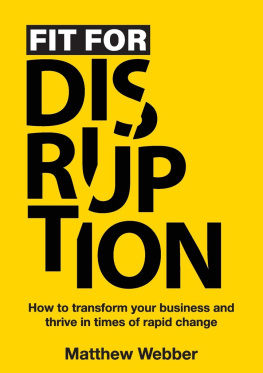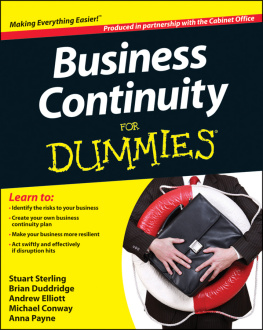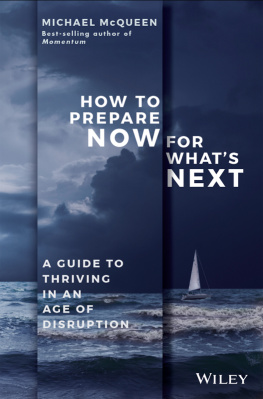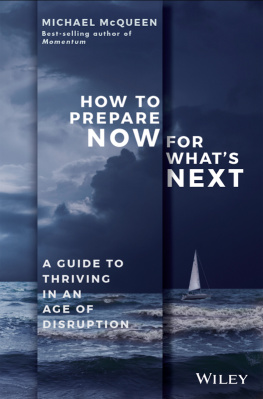
Fit for Disruption
Copyright 2020 by Matthew Webber.
All rights reserved.
Published by Grammar Factory Publishing, an imprint of MacMillan Company Limited.
No part of this book may be used or reproduced in any manner whatsoever without the prior written permission of the author, except in the case of brief passages quoted in a review. All enquiries should be made to the author.
Grammar Factory Publishing
MacMillan Company Limited
25 Telegram Mews, 39th Floor, Suite 3906
Toronto, Ontario, Canada
M5V 3Z1
www.grammarfactory.com
Webber, Matthew, 1976
Fit for Disruption: How to transform your business and thrive in times of rapid change / Matthew Webber.
Includes index.
ISBN: 978-1-989737-04-0
ISBN: 978-1-989737-05-7 (e-book)
1. BUS071000 Business & Economics / Leadership. 2. BUS041000 Business & Economics / Management. 3. BUS063000 Business & Economics / Strategic Planning.
Production Credits
Printed by McPhersons Printing
Cover design by Designerbility
Interior layout design by Dania Zafar
Book production and editorial services by Grammar Factory Publishing
Disclaimer
The material in this publication is of the nature of general comment only and does not represent professional advice. It is not intended to provide specific guidance for particular circumstances, and it should not be relied on as the basis for any decision to take action or not take action on any matter which it covers. Readers should obtain professional advice where appropriate, before making any such decision. To the maximum extent permitted by law, the author and publisher disclaim all responsibility and liability to any person, arising directly or indirectly from any person taking or not taking action based on the information in this publication.

CONTENTS
DEDICATION AND ACKNOWLEDGEMENTS
I would like to dedicate this book to Kelly: my best friend and the beautiful soul I married. I thank you for the love and support that you provide unconditionally. I thank you for and deeply respect your professional counsel and your significant contribution to this book. Above all I thank you for your unwavering belief in me, and for every moment that you have helped me believe in myself. Without you, this book simply would not be. Nor would the next one.
A massive thank you also to those who helped produce this book, and who have taken the time to provide advice and review Simon Murphy, Adam Noakes, Nicholas Canavan and, of course, Kelly. Nicholas, I thank you also for preparing me for this journey.
To Scott, Carolyn and the team at Grammar Factory your remarkable support and guidance made this possible. From the concept design, editing (which was no small feat), cover design, even the name of the book your value is immeasurable, and I cannot thank you enough for helping turn this book into what it is, which is something I am incredibly proud of. I thank also Caroline Czajkowski and Caza Creative for the illustration work that supported bringing the Fit for Disruption concepts to life.
A special mention to my children: Rhylee, Abbey, Noah and Emmer-son. Keep dreaming BIG and believing anything is possible. Keep your minds open and be kind always. Do what you love and love what you do the rest will fall into place. This book is but one example.
INTRODUCTION
KODAK INVENTED THE DIGITAL CAMERA IN 1975. AND YET THEY chose not to develop the technology and continued to rely on profits made by selling film. After all, they thought, they were in the film business why would they promote competitive technology that would threaten their bottom line? The answer, of course, was because if they didnt start selling digital cameras, another company would. Which is precisely what happened, and what put Kodak out of business. The fact that the camera was a digital device meant that new players could enter the market and the distribution strength of Kodak was weakened. While 1975 may have been a little early for the new technology, by the time Kodak realised they needed to act on the innovation, it was too late. They held on to outdated assumptions for too long. They failed to see that the world had shifted and there were new paradigms being created.
Kodak isnt the only example of what, in hindsight, were obviously huge corporate blunders. For example, would you believe that Blockbuster had the opportunity to buy Netflix?
But you dont have to be the next Kodak, or the next Blockbuster. Disruption can kill companies, but the smart ones can find opportunities in disruptive times. Airbnb was founded in 2008. The business was launched at the height of the global financial crisis, and Airbnb provided a way to minimise costs for travellers and also allow homeowners to generate extra income that was needed in tough times. If the concept had been launched years earlier, homeowners might not have had the motivation, or necessity, to come on board. The financial crisis provided the impetus for people to relax their perceptions and have an open mind to new alternatives. Airbnb is now valued at over $20 billion and is in thousands of cities around the world. It competes with the largest of all the hotel chains without owning a single property.
Uber is another example of an innovation that capitalised on disruption. It arrived at a time when people were looking for better value in personal transport. Taxis had become very expensive, and had a bad reputation for cleanliness, comfort and service standards. The uptake of smartphones was peaking at the same time, and convenience was one of the highest priorities for a busy world. Then there was the idle capacity of private vehicles think of how often you drive down a freeway and see a car with just one person in it and people saw this as an opportunity to make extra money during difficult times. But Uber was just the start. There is now an entire shared economy being created out of excess capacity people are on-selling space in their homes (Airbnb), space in restaurants outside trading hours for coworking space (Kettlespace) and even unused personal caravans (Camplify).
Whom would you rather be? Kodak or Airbnb? Blockbuster or Uber?
Each of these companies either capitalised on change or was a victim of change. Today, the world is changing more rapidly than ever, and businesses are becoming more and more likely to be affected by disruption. But remember, disruption also brings opportunity. We dont know what that opportunity will be, but you dont need to know you just need to be change-ready and learn how to make a profit in a disruptive environment.
A CHANGING WORLD
The world we know has changed. The speed, the relationships, the priorities, the tastes. We can access information, goods and services quicker than ever. Companies and governments know more than ever about our behaviours, our habits, our movements, our relationships and our histories.
The way we communicate with each other has changed enormously; we spend less time at the dinner table and more time swiping up, down, left and right for news and updates on our social groups, or even to find a new life partner. We are living in a world that is more connected than ever.
The world has become smaller as travel has become more accessible and affordable, and trade between countries from all corners of the globe has opened. But the political environment is volatile, and we are seeing China and Asia re-emerge in political, social and economic contexts.
Next page









